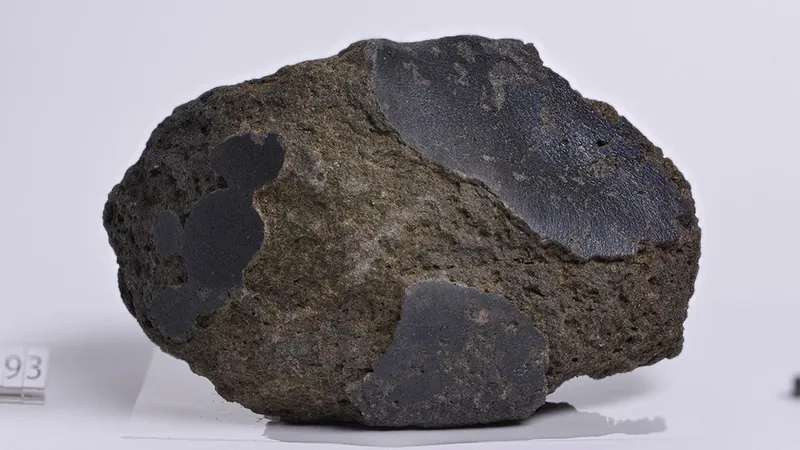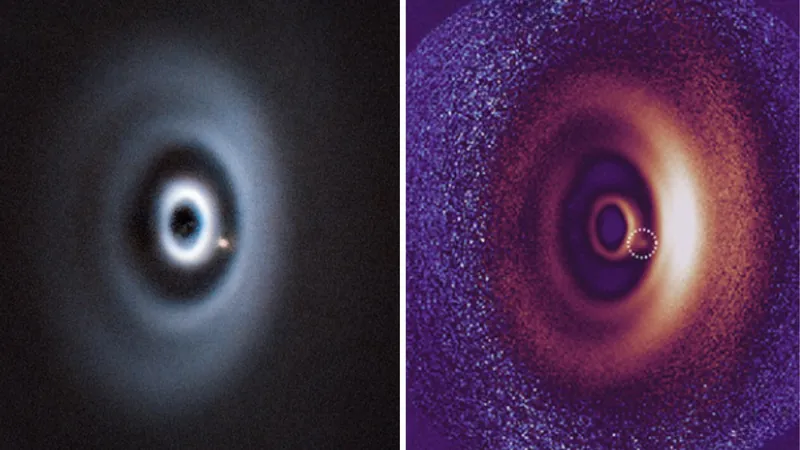
Unlocking the Secrets of Mars: Martian Meteorite Yamato 000593 on Display at Expo 2025
2025-07-14
Author: Siti
A Hidden Treasure Beneath the Ice
Deep within the icy expanses of Antarctica lies a unique collection of meteorites managed by the National Institute of Polar Research in Tokyo. This esteemed facility safeguards over 17,400 meteorite specimens under strict temperature and humidity controls, preserving their secrets for scientific discovery. Among these treasures is the breathtaking Yamato 000593, a Martian meteorite that holds clues to the solar system's origins.
Why Antarctica? The Meteorite Magnet
Antarctica serves as a prime hunting ground for meteorites due to its vast ice sheets. When meteorites fall onto the frozen landscape, they become trapped within the ice, which gradually moves and nudges them towards the surface under the influence of winds and glacial movement. Observers can spot these meteorites easily against the stark backdrop of ancient blue ice, particularly in areas like the Yamato Mountains—where Yamato 000593 was discovered.
Meet Yamato 000593: The Heavyweight Champion of Martian Meteorites
Discovered in 2000 during Japan's 41st Antarctic Research Expedition, Yamato 000593 is a remarkable Martian meteorite weighing in at 13.7 kilograms. Shaped like a rugby ball, this extraordinary find is classified as a nakhlite, a type of igneous rock formed from slowly cooled basalt magma. What makes it especially unique is its status as the world’s largest nakhlite, a feature that greatly enhances its scientific significance.
An Epic Journey of Discovery
The quest for Yamato 000593 began with a dedicated team of researchers braving harsh Antarctic conditions. Traveling in snowcats that towed sleds filled with crucial supplies, they traversed treacherous terrain and battled biting, subzero temperatures. Their determination paid off when they stumbled upon this extraterrestrial gem, along with its smaller companions Yamato 000749 and Yamato 000802.
A Journey from Mars to Antarctica: 1.3 Billion Years in the Making
Scientific analysis confirmed Yamato 000593's origins from Mars, identified through rare gas isotopes and mineral compositions that mirror the Martian atmosphere. The evidence points to a time when liquid water was present—hinting that Mars once supported a more temperate climate. Through rigorous radiometric dating, scientists established that this meteorite formed about 1.3 billion years ago and floated through space for roughly 10 million years before crashing into the Antarctic ice.
The Science of the Cosmos Awaits
Yamato 000593 isn’t just an artifact; it's a key to understanding the solar system's formation and the potential for life beyond Earth. Analyzing meteorites like Yamato 000593 allows scientists to unlock the mysteries surrounding the birth of our solar system, drawing parallels between celestial rocks and our planet's evolution.
A Journey to Expo 2025: Witness the Martian Messenger
Visitors to Expo 2025 in Osaka will have the unique opportunity to see Yamato 000593 up close. More than just a meteorite, it represents a monumental journey spanning billions of years and light-years. By experiencing this cosmic artifact, you not only get a glimpse of Mars but also an insight into humanity's endless quest for knowledge and understanding of the universe.
Don’t miss your chance to witness this piece of the cosmos! Understanding its story will reshape your perspective on space and discovery.


 Brasil (PT)
Brasil (PT)
 Canada (EN)
Canada (EN)
 Chile (ES)
Chile (ES)
 Česko (CS)
Česko (CS)
 대한민국 (KO)
대한민국 (KO)
 España (ES)
España (ES)
 France (FR)
France (FR)
 Hong Kong (EN)
Hong Kong (EN)
 Italia (IT)
Italia (IT)
 日本 (JA)
日本 (JA)
 Magyarország (HU)
Magyarország (HU)
 Norge (NO)
Norge (NO)
 Polska (PL)
Polska (PL)
 Schweiz (DE)
Schweiz (DE)
 Singapore (EN)
Singapore (EN)
 Sverige (SV)
Sverige (SV)
 Suomi (FI)
Suomi (FI)
 Türkiye (TR)
Türkiye (TR)
 الإمارات العربية المتحدة (AR)
الإمارات العربية المتحدة (AR)